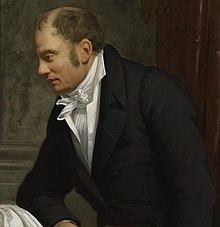François-Dominique Mosselman
François-Dominique Mosselman (born October 8, 1754 in Brussels , † March 19, 1840 in Paris ) was a Belgian private banker and industrialist .
Live and act
François-Dominique belonged to the influential and wealthy Brussels patrician family Mosselman and was the fifth of six children of the cloth merchant Jacques-Dominique Mosselman (1719–1781) and Barbara 't Kind (1724–1773). After school and training, he first got into his father's trading business, but soon went into business for himself as a grain dealer together with his brother Cornelius (1753–1829). Business was going well and the brothers initially supplied the Austrian army and became the main supplier to the French army in the 1790s. During this time François-Dominique Mosselman had a lover to whom he gave the "Hotel d'Autriche" in Brussels, which she then ran herself and in 1790 renamed the Hotel Belgique.
However, in 1797 he married the wealthy Marie Louise Tacque (1776-1828) from Laeken / Laken , who in turn brought several houses and properties into the marriage. In the meantime he had expanded his contacts to Paris and founded a private bank there in 1794, which experienced a rapid boom in the following years. From 1798 he bought a second home in Paris and a little later the villa of a banker, where he brought his young family.
After the turn of the century , Mosselman became aware of the efforts of Jean-Jacques Dony to operate a zinc smelter using new methods in Liège and Kelmis . However, Dony was financially overwhelmed by the modernization of his factory in Saint-Léonard and the expansion of the mine in Kelmis as well as by the establishment of the rolling mill in Angleur and due to poor marketing. Although he then brought the financially strong entrepreneur Hector Chaudet as a partner in the company, which from then on traded as "Dony et Compagnie", to improve the financial situation, the economic decline of the company could no longer be prevented, as the French collapse began The zinc market was completely shattered. Dony was then left sitting on gigantic zinc stocks and had to store more than 80% of the production and the bankruptcy could not be stopped. On April 25, 1813, Mosselman finally acquired three quarters of the ruined company including the smelters, mines and concessions for a ridiculous price. After Dony's death, he took over the remaining shares from his business partner Chaudet in 1819 and then paid Dony's widow and son annual interest as a pension .
For Mosselman it was advantageous that after the Congress of Vienna neither the Dutch nor the Prussian side could agree to whom the area around Kelmis with its mines and factories should belong after the withdrawal of the French. It was only when this became Neutral Moresnet through the Aachen Border Treaty of 1816 that Mosselman was independent in terms of labor and tax law and was able to expand the business at his own discretion and help it to flourish again, which was also the result of the founding of the Belgian state after the Belgian Revolution of 1830 nothing changed. Initially, Mosselman expanded the company to include two smaller rolling mills in the French towns of Heudreville-sur-Eure and Valcanville, as well as another zinc smelter in Neu-Moresnet, and also acquired the rights to use a rolling mill in Dartford, England, for five years . Finally, together with parts of his family, he founded the Société Anonyme des Mines et Fonderies de Zinc de la Vieille Montagne (VM) on May 24, 1837 under Belgian company law and with Belgian and French funds , in which the factories, mines, shares and concessions of "Dony et Compagnie" flowed into it. The company developed into a successful global corporation in the following decades and was integrated into the Union Minière Group in 1989 and renamed " Umicore " in 2001 , whose zinc processing division was sold to Nyrstar in 2007 .
Three years after the foundation, Mosselman died on March 19, 1840. Two children are said to have arisen from his liaison with his beloved and, together with his wife, Mosselmann had eleven other children, including:
- Jenny Mosselman (1799–1867), who married the banker Count Henri Frédéric Fontenilliat, whose daughter Camille became the mother of President Jean Casimir-Perier ,
- Fanny Mosselman (1808-1880), who married the ambassador Charles Le Hon and became the lover of the entrepreneur Charles de Morny , a half-brother of Napoléon III. ; Both partners joined the father's company and became directors or members of the board of directors of Vieille Montagne,
- Alfred Mosselman (1810–1867), who took over his father's company and became director of Vieille Montagne and several other companies.
literature
- Roland d'Anethan & Jonghe d'Ardoye, Les Mosselman à Bruxelles , Bruxelles, Recueil de l'Office généalogique et héraldique de Belgique XLVIII, 1998.
- Susan Becker: Multinationality has different faces: Forms of international business activity of the Société anonyme des mines et fonderies de zinc de la Vieille Montagne and the Metallgesellschaft before 1914 , Franz-Steiner Verlag 2002, p. 50ff digitalisat
- Philipp Dröge: Niemandsland , Piper Verlag GmbH 2018, ISBN 978-3-492-97643-5 digitized
Web links
- Saga: The fabulous destiny of La Vieille Montagne - Episode 2: developers , on the pages of vmzinc.com (French)
| personal data | |
|---|---|
| SURNAME | Mosselman, François-Dominique |
| BRIEF DESCRIPTION | Belgian banker and industrialist |
| DATE OF BIRTH | October 8, 1754 |
| PLACE OF BIRTH | Brussels |
| DATE OF DEATH | March 19, 1840 |
| Place of death | Paris |

